Argumentative Essay: Counterarguments
|
Argumentative
Essay: Outline 5 Paragraph
Essay |
|
1. Introduction a. Hook b. Bridge (Background Information) c. Thesis 2. Body
Paragraph - Reason 1 a. Topic Sentence - Claim b. Textual Evidence – Explanation c. Textual Evidence – Explanation d. Reasoning 3. Body
Paragraph - Reason 2 a. Topic Sentence -Claim b. Textual Evidence – Explanation c. Textual Evidence – Explanation d. Reasoning 4. Body
Paragraph - Opposing Arguments Reason a. Topic Sentence (Claim) b. Textual Evidence for opposing
arguments reason – Explanation c. Rebuttal d. Textual Evidence for
Rebuttal – Explanation 5.
Conclusion a.
Restate Claim (Thesis) b. "So
What" Statement |
"Is
social media more beneficial or risky for teenage students?"
Unit 7 Overview
In an
argumentative essay, the conclusion
is a vital element that provides a final verdict on the topic under discussion.
It summarizes the main points and reinforces the thesis statement, offering the
reader a clear perspective. Effective writing demands the proper use of
language, particularly active and passive voice. Active voice is
preferable as it provides a clear and direct message to the reader, while
passive voice obscures the message. Before writing an argumentative essay, it
is essential to reread the two articles
to ensure a thorough understanding of the topic. Analyzing a sample argumentative essay can also
provide a better understanding of the structure and style used in crafting an
argumentative essay.
(Argumentative Essay
final draft will be submitted in Unit 9)
Conclusion
(Your conclusion will be one paragraph for your argumentative essay.)
An argumentative
essay ends with a conclusion that summarizes and reflects on the arguments made in the
body. A conclusion is
the final paragraph of your essay. It's the last chance to leave an impression
on your reader.
Conclusions
in argumentative essays have two parts.
The
restatement should summarize your thesis and topic sentences to remind readers
of the main points of your essay. Remember to repeat the same words from your
thesis and topic sentences! Express your main points in a new language to make
your conclusion more interesting for your readers.
Below is an example of restating your argument based on a thesis
statement.
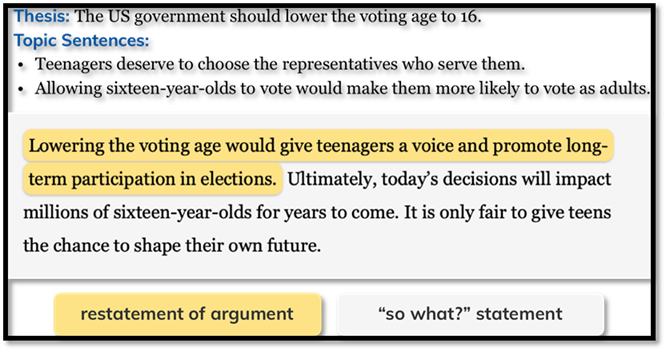
Your "so
what?" statement should drive your argument home by showing readers why
your thesis matters. Try suggesting an action for readers to take, warning them
about the consequence of ignoring your thesis, or appealing to their emotions.
Below is an
example of a "so what?" statement based on a thesis statement.
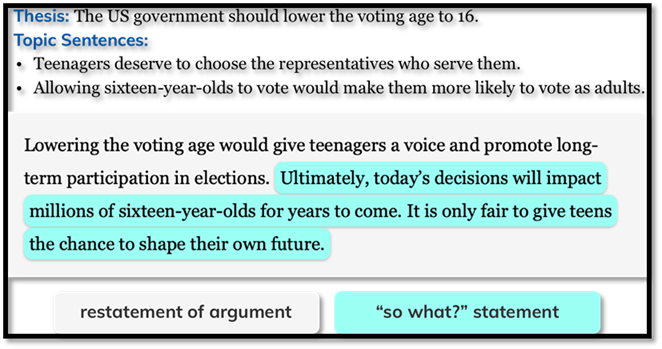
Let's Practice

- Don't distract readers by introducing
new evidence or reasoning in your conclusion! Instead, use your body
paragraphs to present new ideas and your conclusion to summarize or
reflect on those ideas.
- Your conclusion should leave readers
with a sense of closure.
Your readers should feel that the essay has ended and left them with an
action to take or a question to consider.
Active and Passive
Voice
Have you
ever noticed how some parts of your writing pop while others don't? You can
improve those dull sentences if you take a moment to consider the active and
passive voices.
There are two voices in writing: Active
and Passive.
In the active voice, the subject of a
sentence acts like "Neil
Armstrong walked on the moon."
The active
voice is direct, clear, and easy to read. In active voice sentences, the
subject is doing the action. This is usually clearer for readers to
understand.

In the passive voice, the subject is acted
upon, like "The moon
was walked on by Neil Armstrong."
Although
the passive voice is still grammatically correct, it typically doesn't carry the
same energy or clarity as the active voice.
Its
structure can feel clumsy and unnatural, which makes your writing harder to
read. It also tends to use more words than the active voice. Over the course of
a document, all those extra words can make your writing drag.
You should
use the active voice more often than the passive in writing. This
will help keep your writing snappy and efficient.
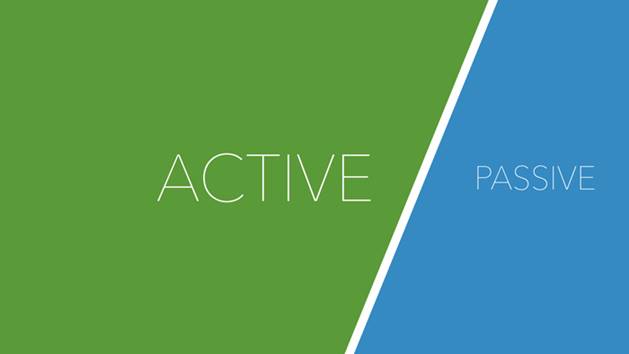
Creating
Active Voice Sentences
A subject is part of
the sentence doing an action or being something.
A sentence is in the active
voice if the subject is doing the action.
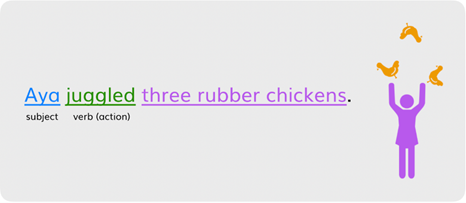
In the example above, the subject—Aya—is doing the juggling.
A sentence is in the passive
voice if an action is being done to the subject.

In the second example, the subject—the rubber chickens—didn’t do the
juggling. Aya did the juggling to the
rubber chickens.
Sentences in the passive voice include a version of the verb "to
be," such as "is," "was," or "being."
Let’s Practice
Argumentative Text
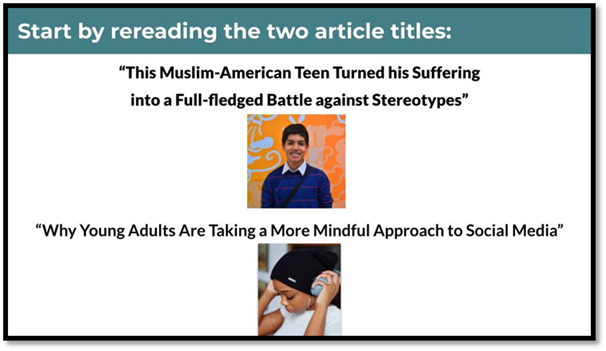
Start by rereading the two article titles: "This Muslim-American Teen Turned his Suffering into
a Full-fledged Battle against Stereotypes" and "Why Young Adults Are Taking a More Mindful Approach to Social Media."
Be sure you do the following as you are reading:
1.
Review
any notes or annotations from the first time you read the articles. This can
help refresh your memory of each article's key ideas and evidence.
2.
Pay
attention to any new insights or details you may have missed the first time you
read the articles. Rereading can often reveal new information or help deepen your
understanding of the material.
3.
Consider
any questions or areas of confusion you had the first time you read the
articles. Rereading can provide an opportunity to clarify any uncertainties and
better understand the material.
4.
Compare
and contrast the two articles more closely. Pay attention to similarities and
differences in the evidence presented, the arguments made, and the overall tone
and perspective of the authors.
5.
After
rereading, reflect on what you have learned and how the articles have impacted your
understanding of social media and its effects on the mind. Consider any
implications for your own social media use and habits.
Analyzing a Sample Argumentative Essay

You are about to read a sample argumentative essay. As you are reading,
remember the structure of your argumentative essay:
Paragraph 1: Introduction
Paragraph 2: Body Paragraph – Reason One
Paragraph 3: Body Paragraph – Reason Two
Paragraph 4: Body Paragraph – Counterargument
Paragraph 5: Conclusion
Below is a list of argumentative key terms. Study the list before reading the sample
essay.
|
UNIT 6 KEY TERMS These terms will
appear throughout the unit. Use this reference sheet as needed. |
|
|
Argument |
A genre of writing
where the writer conveys their position on a topic and uses research,
evidence, and reasoning to persuade others |
|
Audience |
The group of people
that a piece of writing, media, or art is intended for |
|
Claim |
The main argument of
the essay. All of the reasons and evidence support the claim.
|
|
Counterclaim |
A point made by the
opposing side in an argument |
|
Rebuttal |
Reasoning and
evidence that attempts to disprove or point out weaknesses in the
counterclaim |
|
Refute |
To prove an idea is
wrong or false; disprove |
Click here to read the
sample argumentative essay.
Let’s Practice